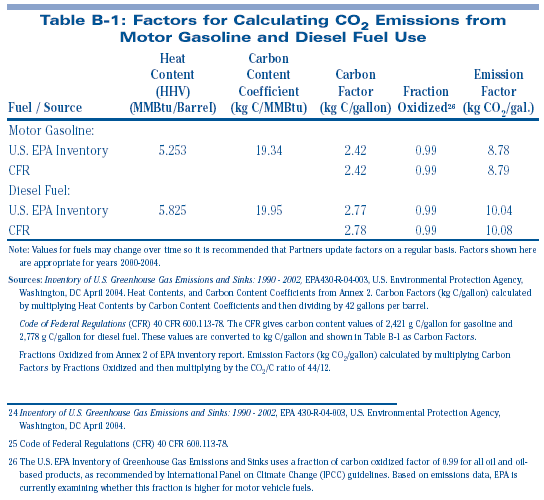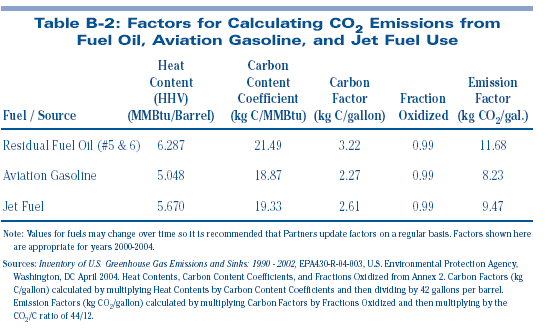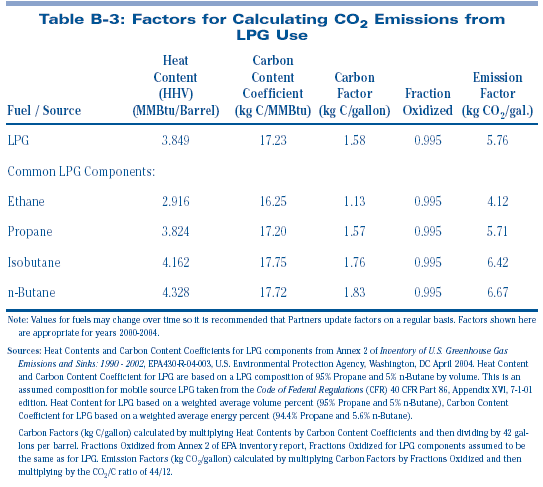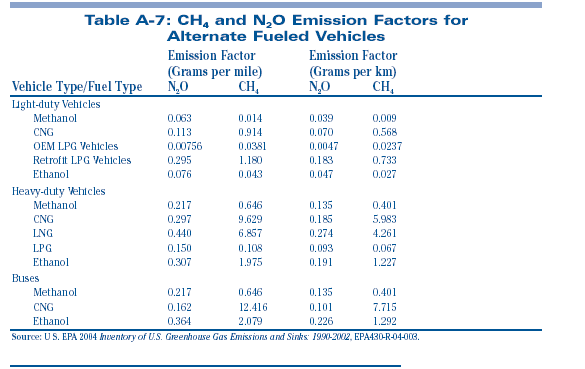
Calculating CO2 Emissions from Mobile Combustion Sources
T
his appendix contains factors for use in calculating CO2 emissions for different types of transportation fuels.Motor Gasoline and Diesel Fuel
Factors for motor gasoline and diesel fuel are presented in Table B-1 from two different sources. The U.S. EPA National Inventory 5 of Section 4.2. report
24 provides values based on the energy content of the fuels.The Code of Federal Regulations (CFR)25 provides values based on the carbon content of the fuel and fuel density for each fuel type.

Fuel Oil, Aviation Gasoline, and Jet Fuel
Factors for residual fuel oil (#5 & 6), aviation gasoline, and jet fuel are presented in Table B-2.
The factors were taken from the U.S. EPA National Inventory report based on the energy content of the fuels.

Liquefied Petroleum Gas (LPG)
Factors for LPG and LPG components are presented in Table B-3. The factors for LPG were based on the physical characteristics of LPG components and an assumed LPG composition.
If a Partner knows the specific blend of LPG that they are using in their mobile sources which could include any of the components listed in Table B-3, heat content and carbon content coefficients for different blends of LPG can be calculated based on the percent mix and individual component characteristics shown in Table B-3.

Natural Gas (Compressed and Liquefied)
Natural gas can be used as a mobile source fuel in a compressed or liquefied form. Factors for compressed natural gas are presented in Table B-4 based on the energy content of the fuel.
Factors for liquefied natural gas are presented in Table B-5 based on the carbon content of the fuel.

Ethanol
Factors for ethanol are presented in Table B-6. The factors were taken from the U.S. EPA National Inventory report based on the energy content of the fuel. As per Section 1.3, emissions from ethanol combustion are treated as biomass CO
2 and listed as supplemental information on a Partnerís inventory report. The values in Table B-6 represent 100% ethanol, if a Partner is using E85, the activity data for E85 total fuel use (e.g., in gallons) would have to be split into 85% ethanol and 15% gasoline. The factors in Table B-6 would be used for the ethanol portion of the fuel and the values in Table B-1 would be used for the gasoline portion of the fuel.
Biodiesel
Factors for biodiesel are presented in Table B7. The factors are based on the carbon content of the fuel. As per Section 1.3, emissions from biodiesel combustion are treated as biomass CO
2 and listed as supplemental information on a Partnerís inventory report. The values in Table B-7 represent 100% biodiesel, if a Partner is using B20, the activity data for B20 total fuel use (e.g., in gallons) would have to be split into 20% biodiesel and 80% diesel fuel. The factors in Table B-7 would be used for the biodiesel portion of the fuel and the values in Table B-1 would be used for the diesel portion of the fuel.


![]()